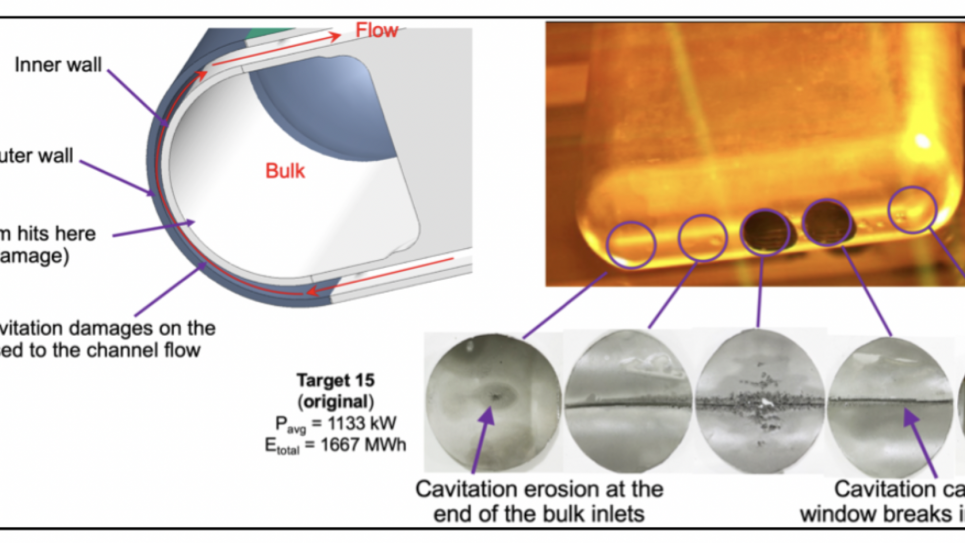
Left: schematic of the nose of the SNS targetand highlighting different regions of interest. Right: samples taken from target 15 illustrating cavitation damage.
The objective of this research is to simulate the collapse of individual gas bubbles in channel flow, in order to understand the role of confinement and shear on the bubble dynamics and resulting shock waves and to connect these phenomena to cavitation damage.
The Spallation Neutron Source (SNS) at Oak Ridge National Laboratory produces the most intense neutron beam in the world. Neutron scattering can be used to uncover the molecular and magnetic structure of materials and has allowed ground-breaking discoveries in chemistry, biology, and materials science, among other fields. A highenergy pulsed proton beam impinges upon a flowing liquid mercury target, in which the spallation reaction occurs, thus producing neutrons. The pressure waves generated by this energy release reverberate within the target, ultimately giving rise to low-pressure regions in which the mercury cavitates (i.e., vaporizes). Such cavitation bubbles oscillate in response to the pressure field. If they reach a sufficiently large size, their collapse produces shock waves with the potential to cause structural damage. Although collapsing bubbles have been studied extensively in water under stationary conditions, cavitation in liquid metals such as mercury is far less well understood; for instance, the high density may produce stronger shocks, while the low vapor pressure may lead to smaller bubbles than in water. Additionally, the role of the flow (e.g., in certain regions of the SNS target) on the bubble dynamics is not well understood; for instance, the rotationality of the flow may lead to weaker shock waves, though perhaps they originate closer to the surface and thus may cause more damage. As higher neutron beam intensities are sought, cavitation damage is expected to become increasingly important and lifetime-limiting. Such cavitation induced damage is also problematic in liquid-metal-cooled reactors or thermal hydraulic systems during transient events such as steam explosions or water hammers. There is therefore a need to better understand cavitation dynamics in liquid metals and devise mitigation strategies.
In particular, the dependence of the magnitude of the maximum wall pressure (damage surrogate) on the stand-off distance of the bubble from the wall, on the local shear rate, and on the liquid will be determined. Additionally, the interaction of multiple bubbles with each other will be considered to determine the circumstances under which the emitted shocks are stronger or weaker than in the case of a single bubble. Finally, energy transfer between a macroscopic bubble and a small bubble will be investigated in the context of mitigation strategies for cavitation activity. In addition to new knowledge, these highly resolved simulations will provide data essential to developing data-driven models representing clouds of non-spherically collapsing bubbles. This research will be conducted using an in-house code for massively parallel direct simulations of the compressible Navier-Stokes partial differential equations in three dimensions for gas/liquid flows. The base spatial schemes are nominally nondissipative (high-order accurate capturing at discontinuities, no dissipation in smooth regions) with numerical dissipation applied only where needed and explicit time-marching is used. This approach accurately ad robustly handles discontinuities such as interfaces and shock waves.